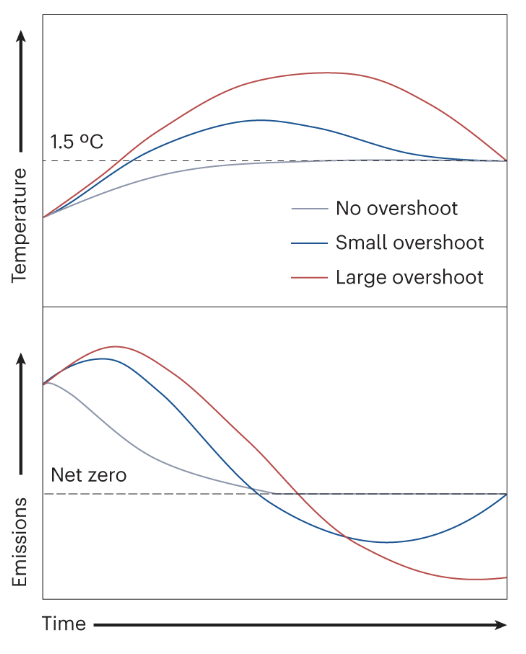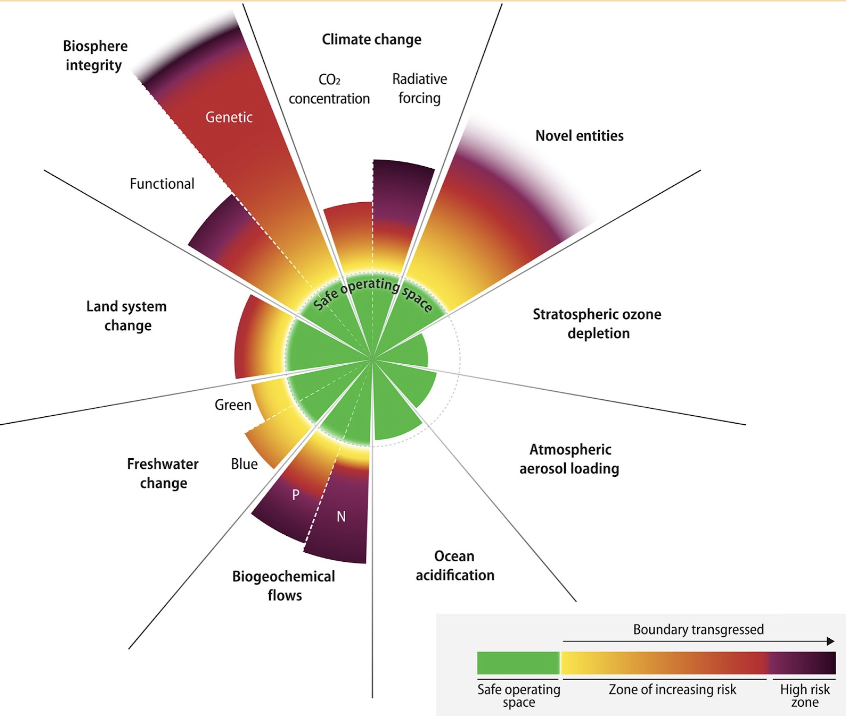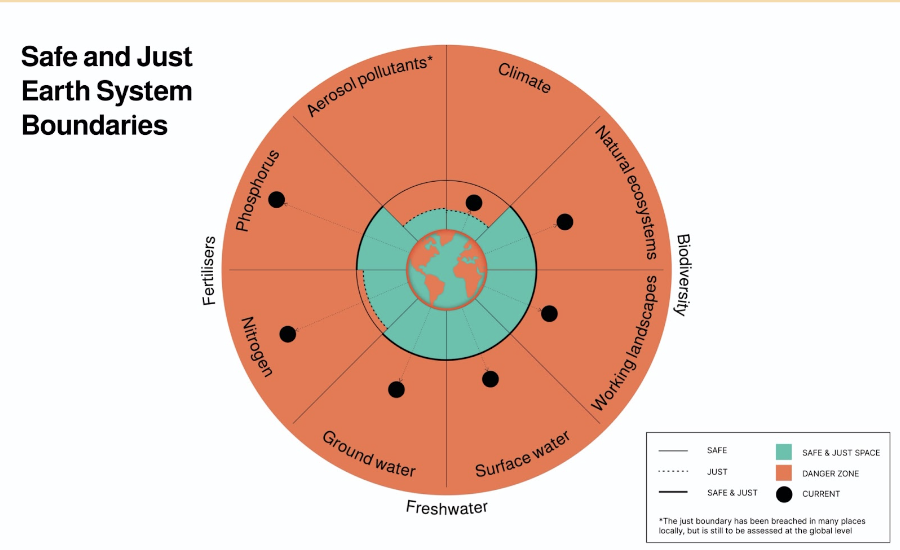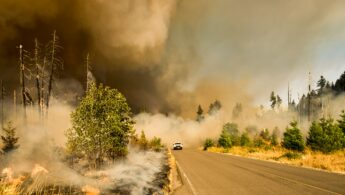Unpacking 2023’s unprecedented heat
June, July, August, September and October this year were unambiguously the hottest months since records began in the mid-1800s.

The earth has heated by around 1.3°C, on average, since pre-industrial times as a result of human activities – primarily the burning of fossil fuels. This warming has had widespread adverse impacts on people and nature. These impacts will worsen as the climate continues to warm. Every fraction of a degree of warming increases the odds of additional, and often extreme, impacts. As greenhouse gases continue to build up in the atmosphere, heatwaves are becoming hotter and more frequent, and rainfall is becoming more intense and variable. One consequence of this is that droughts and floods are worsening globally, triggering crop failure, infrastructure damage and humanitarian crises.
To avoid the most devastating impacts of climate change, at COP21 in 2015 the Paris Agreement was adopted by most states worldwide – states who are collectively responsible for 98% of human-caused emissions – with the primary goal of keeping “the increase in the global average temperature to well below 2°C above pre-industrial levels” and to pursue efforts “to limit the temperature increase to 1.5°C above pre-industrial levels” by the end of the century.
However, it is now clear that achieving Paris Agreement goals will require stricter emissions mitigation measures – net carbon dioxide emissions will need to decline by 48% by 2030 in order to keep warming to 1.5°C. Based on historical trends in carbon intensity (the CO2 emissions per unit of GDP) and global population growth, one peer-reviewed analysis suggests that the chance of staying within 1.5°C and 2°C of warming by 2100 may only be 1% and 5% respectively. A more recent analysis suggests that even if countries fulfil the pledges they made under the Paris Agreement to help limit warming to 1.5°C, known as Nationally Determined Contributions (NDCs), and continue to decrease emissions at the same rate after 2030, the probability of staying below 2°C is around 26%. The 2023 Emissions Gap Report finds that even under an optimistic scenario whereby all NDCs and net zero pledges are met, the chance of limiting warming to 1.5°C by end-century is only 14%.
The latest stocktake of the global carbon budget – the amount of carbon that can be emitted before we reach 1.5°C of warming – estimates that we will burn through the remaining carbon budget within the next decade. Other estimates indicate that we may only have six years left to reduce emissions enough to limit warming to 1.5°C. It is also suggested that for a 50% chance of keeping warming to 1.5°C, greenhouse gas emissions need to peak before 2025, yet emissions continue to rise, and national commitments to reducing emissions remain insufficient. Without concerted and unprecedented effort to stop burning fossil fuels now, our journey to achieving 1.5°C of warming will entail ‘temperature overshoot’.
Temperature overshoot is the term used by the Intergovernmental Panel on Climate Change (IPCC) to describe scenarios, or ‘pathways’, in which we exceed a specified global warming level – typically between 1.5 and 2°C – before returning to that level at some point in the future. The magnitude (how much the specified level is exceeded) and the duration (how long that level is exceeded for) differ across pathways. The duration of the overshoot in most temperature overshoot pathways is at least one decade and up to several decades, and the magnitude of the warming reaches up to 0.5°C. However, in pathways where the temperature overshoots by as much as 0.5°C, known as ‘high overshoot pathways’, it is unlikely that warming could be returned to ‘well below 2°C’ by 2100. If we follow these pathways, we will not meet the terms of the Paris Agreement.
Pathways with temperature overshoot are not exceptional. In the IPCC report Global Warming of 1.5°C, 90% of the mitigation pathways that limit warming to 1.5°C by 2100 include a period of temperature overshoot. Those pathways that limit warming to 1.5°C with limited or no overshoot require deep, rapid and immediate reductions in emissions, with carbon dioxide removal (CDR), such as planting forests or bioenergy with carbon capture and storage (BECCS), used only to compensate for historical emissions and those sectors for which no mitigation measures are available.[1] ‘Limited-overshoot’ pathways overshoot 1.5°C by no more than 0.1°C. On the contrary, those pathways that delay emissions cuts overshoot the target and will need to rely more heavily on large-scale CDR to bring global temperatures back down by the end of the century. The longer emissions reductions are delayed, the more greatly CDR – which has various risks and uncertainties – will need to be deployed, and the more we risk exposing nature and people to severe climate impacts for decades to come.

Figure 1 shows three hypothetical examples of overshoot scenarios for pathways that achieve 1.5°C. In the upper panel, the grey line represents a scenario in which there is no temperature overshoot. The blue line shows a scenario with a low magnitude and short duration of temperature overshoot. The red line is a scenario where there is a high magnitude of temperature overshoot that lasts for a long time. In the blue and red scenarios, temperatures return to 1.5°C by the end of the century. The lower panel shows emissions trends in each of the pathways: The scenario represented by the grey line reaches net-zero emissions – at which point temperatures stabilise at 1.5°C – by rapidly reducing emissions and without the need for negative emissions solutions. By contrast, the scenarios represented by the blue and red lines require negative emissions solutions, such as large-scale CDR, in order to reach net-zero emissions. In the red scenario of large and long-lasting overshoot, negative emissions solutions will need to be deployed far beyond the end of the century. The greater and longer the overshoot, the more negative emissions solutions will be needed in order to stabilise temperatures at 1.5°C.
2023 has been hot: Multiple new heat records have been made on land and in the sea this year. Scientists are certain that 2023 will be the first year since pre-industrial times where the average global temperature exceeds 1.5°C. Though a breach of the Paris Agreement target would require average annual temperatures to be above 1.5°C for at least 20 concurrent years, the fact that we are increasingly seeing individual months – and potentially years – surpassing 1.5°C implies that we are getting closer.
The target of 1.5°C was chosen by the IPCC as a threshold beyond which the impacts of warming become increasingly intolerable to humans and nature. This assessment was made based on criteria such as food security, extreme weather events, health, biodiversity loss, water supply and economic growth. However, IPCC scientists urge that 1.5°C shouldn’t be viewed as a guardrail – a ‘safe’ limit to global warming does not exist. What is considered an acceptable level of damage from global warming will be highly subjective. At just 0.56°C of warming, 506 people died from climate change-induced heat stress in Paris in summer 2003. At 0.95°C of warming, wildfires in Australia in 2019-2020 led to the death or displacement of three billion wild animals and caused AUD 4-5 billion in losses to the Australian food system.
We have not yet reached the 1.5°C target, but we are already experiencing the impacts of global warming. This year alone, extreme wildfires in Canada burnt over 13 million hectares of forest, while torrential rain in the Mediterranean led to the loss of thousands of human lives. These represent just a tiny fraction of all impacts as a result of human-caused warming.
We should do everything in our power to keep warming down as much as possible. As emphasised by IPCC scientist Prof. Mark Howden five years ago: “Every half a degree matters. Every year matters. Every choice matters.”
Every increase in the magnitude and duration of overshoot increases the severity, frequency and duration of climate impacts, such as heatwaves, droughts and floods. In one analysis, the frequency of agricultural drought increases from 24% under a 1.5°C scenario with little to no overshoot, to 31% under an overshoot scenario that reaches just below 2°C by the end of the century. Under the same scenarios, the frequency of major heatwaves increases from 29% to 44%. Brazil, North Africa and southern Africa are projected to be the most impacted by heatwaves worsened by temperature overshoot.
Sticking to the 1.5°C target also brings economic benefits – climate impacts from temperature overshoot will lead to higher mitigation costs and economic losses later in the century.[2]While higher initial investments are needed to keep temperatures down, this is outweighed by the economic benefits later in the century.
For nature, exceeding a temperature threshold for even a short amount of time may push species beyond their thermal tolerance limits – the maximum temperature at which they can survive – causing extinction and migration, with knock-on effects for entire ecosystems. Some of the world’s most important ecosystems, such as the Amazon Basin, the Pantanal – the largest tropical wetland in the world – and the Coral Triangle, could be irreversibly transformed with just a few years of overshoot. As different parts of the world warm and cool at different rates, species across the world would be unevenly exposed to dangerous conditions. Temperature overshoot will be particularly critical for species already living close to their thermal limits, such as those in the tropics.
The IPCC estimates that the area of global land at risk of changing from one ecosystem type to another – such as a forest changing to a grassland – is 50% lower at 1.5°C of warming compared to 2°C. In the ocean, overshoot is projected to decrease ecosystem habitability for centuries to come. If we do not curtail emissions now, marine ecosystems in the Indo-Pacific, Caribbean and West Africa could experience sudden collapse as early as the 2030s, with knock-on effects for the people who rely on these ecosystems for food and income from tourism.
Overshooting temperature targets, even temporarily, risks the creation of a positive feedback loop – a self-perpetuating cycle that speeds up warming. These positive feedback loops, if uninterrupted, can trigger climate ‘tipping points’, after which an earth system is transformed into an alternative stable state – an environmental state that is completely different from the original state.
For example, the Amazon is drying and burning due to human-caused warming, which reduces tree cover. Reduced tree cover – aggravated by deforestation – causes further reductions in rainfall as a result of less evapotranspiration, whereby moisture is evaporated into the atmosphere from trees. Over time, this deforestation-drought feedback loop could pass a tipping point, after which the region will be transformed from a rainforest into a savanna, altering it from one of the most important global carbon sinks to a carbon source. This could also trigger potentially catastrophic changes to global rainfall patterns, with impacts for agricultural production – emphasising how one tipping point can cause cascading and catastrophic effects at regional and global scales.
Scientists are uncertain when this tipping point might be crossed. Some estimates suggest this could happen at 40% forest loss – and around 26% of the Amazon is already deforested or degraded. Some scientists believe that the first warning signals of this shift are already here. The transformation of the Amazon is a ‘fast-onset tipping point’, in that when the tipping point is transgressed, the change in the climate system would occur rapidly – in a matter of decades. For these tipping points, overshoot could cause sudden and irreversible changes to the system.
Other tipping points are ‘slow-onset tipping points’, whereby the change to an earth system occurs over a much longer timescale, such as over many centuries. For these tipping points, briefly overshooting temperature targets might not cause immediate and irreversible changes to the climate system, as long as the overshoot is not longer than the time needed for the system to recover. One example is the melting of the Greenland ice sheet. While we may be close to this tipping point, it is estimated that ice sheet loss could be mitigated as long as temperatures are brought back down to 1.5°C or lower relatively quickly once the tipping point is reached.
Even temporary overshoot increases the risks of surpassing critical tipping points by 72% compared to scenarios with no overshoot. Keeping the magnitude and duration of overshoot as low as possible is critical and rapid decarbonisation is key: While delaying emissions reductions to beyond 2030 could still allow us to meet 1.5 °C by the end of the century, this would result in higher temperature overshoot over many decades, with the potential for adverse consequences.
Humans have altered the earth, such as by depleting the ozone layer, reducing biodiversity, changing land cover and warming the atmosphere. Scientists have tried to estimate how far these processes could continue to be altered until a global tipping point would be reached, causing the earth to transform irreversibly into a state that could endanger humanity and render the planet uninhabitable.
The concept of planetary system boundaries involves tracking changes to nine crucial processes, identified by scientists as responsible for keeping the earth habitable. These processes are ranked on a scale from ‘safe operating’, meaning the process happening in a way that is safe for humanity, to ‘high-risk’, i.e. the process is posing a high risk to humanity.
Of the nine identified planetary boundaries, the earth is already outside the safe zone for six – climate change, biosphere integrity (the quality of living organisms and ecosystems, impacted by, for example, decreasing species diversity), land-use change, biogeochemical flows (for example of nitrogen and phosphorous – aggravated by agribusiness and industry), novel entities (the release of novel chemicals such as plastics) and freshwater change (Figure 2).

There is great scientific uncertainty regarding how much longer we can continue to push these boundaries before total collapse of the earth system happens. However, if we rapidly decarbonise, we could reduce this risk and stabilise the earth within a safe operating space.
Scientists have also proposed a set of ‘safe and just’ earth system boundaries that quantify the safety of humans and the stability of the planet. Safe boundaries are those “where biophysical stability of the Earth system is maintained and enhanced over time, thereby safeguarding its functions and ability to support humans and all other living organisms”. Just system boundaries minimise the exposure of countries, communities and people to significant harm, including “loss of lives, livelihoods or incomes, displacement, loss of food, water or nutritional security, chronic disease, injury or malnutrition”. This framework differs from previous frameworks in that the impacts on people have been measured in comparable units to impacts on the planet. While other frameworks only assess how human activities have impacted earth systems, using comparable units allows for a better understanding of the harm to humans as a result of changes to earth system boundaries. The framework focuses on all species, not just humans, attempting to “define the environmental conditions needed not only for the planet to remain stable, but to enable societies, economies and ecosystems across the globe to thrive”. The framework also incorporates information on climate, biosphere and other earth system tipping points into the earth system boundaries.
Incorporating justice into the framework makes staying within planetary boundaries even more challenging, with seven of the eight earth system boundaries already transgressed (Figure 3). According to this framework, the ‘just’ earth system boundary for climate is 1 °C, while the ‘safe’ boundary is 1.5 °C. As the earth has already heated by more than 1.2 °C, current global warming, while still in the ‘safe’ zone, is unjust (Figure 3), emphasising the need for urgent action. As the framework incorporates interspecies justice, intergenerational justice and intragenerational justice (including race, class and gender), it could be used to inform sustainability targets and practices.

However, these frameworks have been criticised, with some suggesting that they are too simplistic, or that they do not distinguish between thresholds – which can be breached – and hard limits – which cannot be breached. They may also shift political focus to the wrong areas or dampen political action. Others warn against allowing one group of scientists to define what constitutes a safe set of boundaries for everyone on the planet, which could be viewed as divisive.
In order to bring average global temperatures back down to between 1.5 and 2°C, overshoot scenarios rely to different extents on CDR. This includes nature-based solutions, such as planting forests (afforestation), and BECCS, where bioenergy crops are grown, burnt to create energy, and the released carbon is captured and stored long-term underground. Other solutions include direct air capture (DAC) and storage, whereby CO2 is directly captured from the air and then stored long term.
However, there are major risks and uncertainties with these approaches. With nature-based CDR and BECCS, there is a risk that ecosystems could be replaced with bioenergy crops or plantations, endangering wild plants and animals, and food crops could be supplanted, threatening food security. DAC technology is still in its infancy. These technologies are also not proven to work at the scale needed.
These uncertainties and risks emphasise that climate action needs to be boosted in the near-term in order to reduce our reliance on these approaches for bringing temperatures back down later in the century.
In contrast to climate tipping points, positive tipping points, otherwise known as positive socio-economic tipping points, arise when a set of conditions are reached that can accelerate the deployment of technologies or practices to reach net zero. For instance, a new technology begins to outcompete an old technology. Sales in the new technology facilitate further development, which reduces its costs, with the end result that the new technology becomes widespread and replaces the old technology. An example of this is the speed at which renewable energy has developed – over just 10 years, solar and wind technologies have become the cheapest source of power in many parts of the world.
Targeted interventions in socioeconomic, technological, and political systems can be used to advance climate change mitigation, and strategic investment can help bring down the costs of key technologies and facilitate decarbonisation, allowing us to meet the 1.5°C target. As an example, oil and gas companies have been accused of having overly optimistic projections of long-term oil prices, resulting in an inflated picture of future economic performance. Updating the accounting standards or disclosure guidelines for these companies could cause prices to decrease such that investment would be curtailed, catalysing investment into renewables. A number of other interventions have also been detailed in The Breakthrough Effect.
However, the focus on these positive tipping points should not distract us from rapidly decreasing emissions. Rather, these positive tipping points should be viewed in the context of driving strategic intervention in order to encourage decarbonisation.
References
| ↑1 | ‘Limited-overshoot’ pathways overshoot 1.5°C by no more than 0.1°C. |
|---|---|
| ↑2 | While higher initial investments are needed to keep temperatures down, this is outweighed by the economic benefits later in the century. |

June, July, August, September and October this year were unambiguously the hottest months since records began in the mid-1800s.

Many countries are already experiencing the impacts of climate change, including droughts, floods and heatwaves, and El Niño is likely…